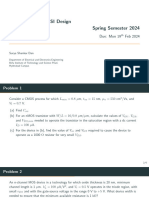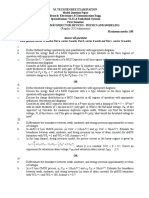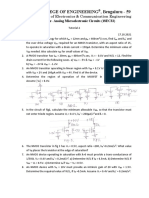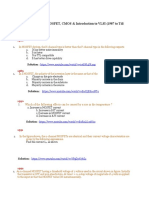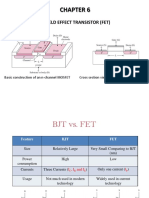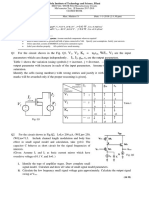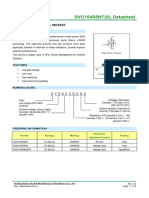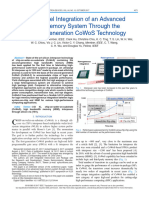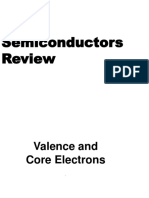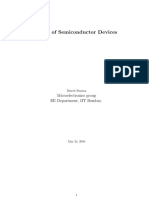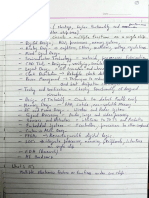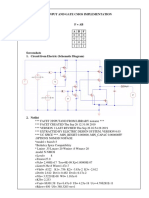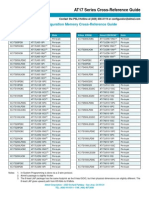VLSI DESIGN TUTORIAL - 1
Q1. Calculate the threshold voltage 𝑉!" at 𝑉#$ = 0, for a polysilicon gate n-channel MOS transistor, with
the following parameters: substrate doping density 𝑁% = 10&' 𝑐𝑚() , polysilicon gate doping density 𝑁*
= 2 x 10+" 𝑐𝑚() , gate oxide thickness 𝑡,- = 500 Å, and oxide-interface fixed charge density 𝑁,- = 4 x
10&" 𝑐𝑚(+ .
Q2. Consider the following p-channel MOSFET process:
Substrate doping 𝑁* = 10&. 𝑐𝑚() , polysilicon gate doping density 𝑁* = 10+" 𝑐𝑚() , gate oxide thickness
𝑡,- = 650 Å, and oxide-interface charge density 𝑁,- = 2 x 10&" 𝑐𝑚(+ . Use 𝜀/0 = 11.7𝜀" and 𝜀,- = 3.97𝜀"
for the dielectric coefficients of silicon and silicon-dioxide, respectively.
Calculate the threshold voltage 𝑉!" , for 𝑉#$ = 0
Q3. A PMOS transistor operates in the linear region with the following parameters:
𝑉1# = −2 𝑉, 𝑉*# = −0.5 𝑉, 𝑉23 = −1 𝑉, µ4 𝐶,- = 50 µ𝐴/𝑉 + , W/L = 2
Calculate the drain current 𝐼* .
Q4. An NMOS transistor operates in the saturation region with the following parameters:
𝑉1# = 2.5 𝑉, µ5 𝐶,- = 150 µ𝐴/𝑉 + , W/L = 3
If Vth is reduced from 1.2 V to 1V then calculate the change in 𝐼* .
Q5. An NMOS transistor operates in the saturation region with:
!
𝑉1# = 3 𝑉, 𝑉*# = 2.5 𝑉, 𝑉23" = 1 𝑉, γ = 0.4 𝑉 " , |2ɸ6 | = 0.6 V, 𝑉#$ = 1.2 𝑉,
µ5 𝐶,- = 100 µ𝐴/𝑉 + , W/L = 3
Calculate the drain current (𝐼* ) considering the body effect.
Q6. Measured voltage and current data for a MOSFET are given below. Determine the type of the
device, and calculate the parameters 𝑉!" , k and γ. Assume 2ɸ6 = -0.6 V. (Neglect the channel
length modulation effect)
𝑉1# (𝑉) 𝑉*# (𝑉) 𝑉#$ (𝑉) 𝐼* (µ𝐴)
2 3 0 97
4 4 0 235
5 5 0 433
3 3 3 59
4 4 3 173
5 5 3 347
Q7. Two identical long channel NMOSTs having same length L and widths W1 and W2 are connected
in parallel is equivalent to a MOSFET of length L and width W. Find the value of W valid for all
regions of operation. (Neglect channel length modulation and body bias effects).
�Q8. Find the final value of the voltage 𝑉" , justify your answer in one sentence. Assume 𝑉25 = |𝑉24 | =
0.5V. Assume that the capacitor is initially discharged, and ignore subthreshold conduction and
body effect.
Q9. Express Vout in terms of Vin. Find VOH, VOL
Q10. Consider the circuit below.
a) Find if the body bias effect is present for M4 or M5.
b) Identify the region of operation of M4 and M5 (Off, Linear, Saturation, Velocity
saturation) neglecting body bias effect if it is present. Assume short channel devices
and M4 and M5 have the same W/L ratios. VDD = 2.5V.
c) Find Vx
�Q11. Design a CMOS inverter (find the W/L ratios) with 𝑉** = 2.5V for 𝑉7 = 1:25V. Take NMOS
transistor parameters as 𝑘′5 =120µ𝐴𝑉 (+ , 𝑉*#%!5 = 0.6V, 𝑉!"5 = 0.4V, λn = 0 and PMOS transistor
parameters: 𝑘′5 = −30µ𝐴𝑉 (+ , 𝑉*#%!4 = −0.6𝑉, 𝑉!"4 = −0.4𝑉, λp = 0. Assume that a MOSFET
operating in saturation region.
Q12. Consider a capacitor 𝐶8 getting discharged from 𝑉** to 𝑉** /3 (with respect to GND) through an
NMOS with gate voltage 𝑉** . If 𝐼*#%! is the current at velocity saturation voltage VDSAT and λ the
channel length modulation coefficient, find the equivalent resistance of NMOS and hence obtain the
expression for the time constant associated with the above mentioned transient. Assume that 𝑉** /3
-+ -)
>𝑉*#%! . Take ln(1 + 𝑥) = 𝑥 − + + ) .






















